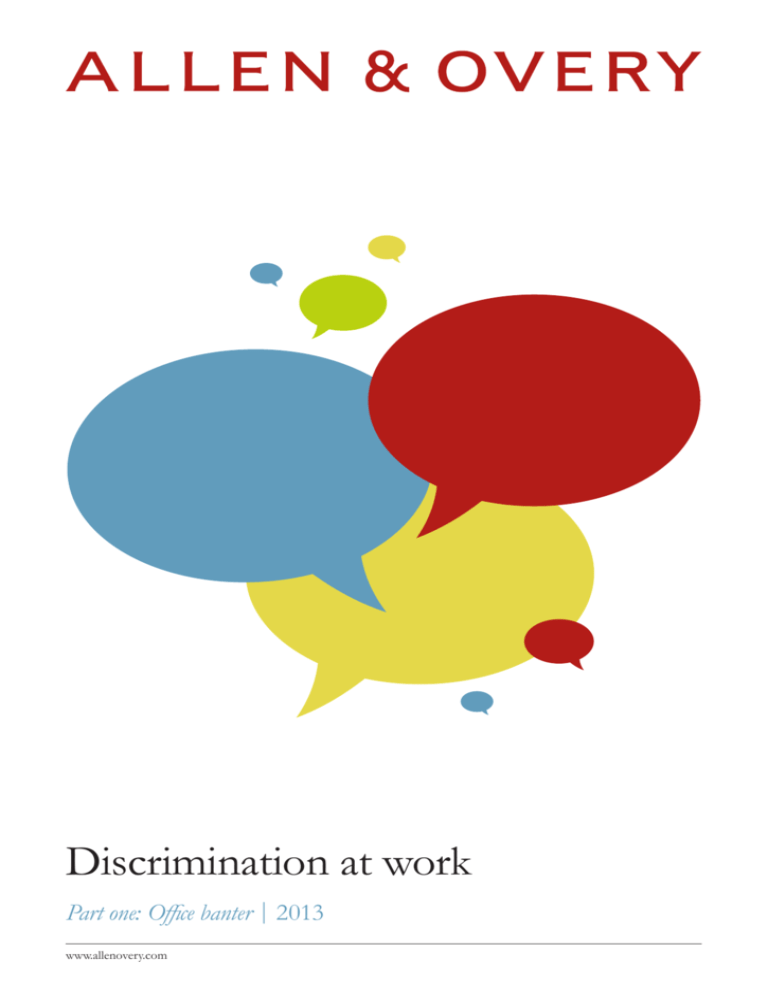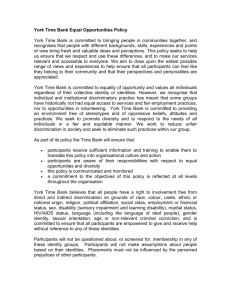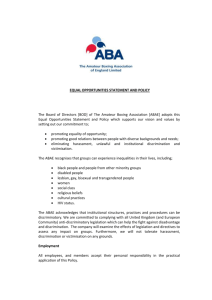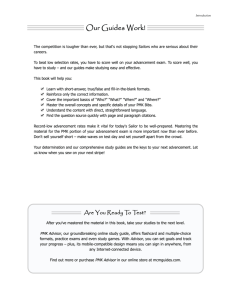our Discrimination at work
advertisement

Discrimination at work Part one: Office banter | 2013 www.allenovery.com 2 Discrimination at work | Part one: Office banter | 2013 About this report This report examines some of the factors contributing to discrimination at work. A&O conducted a quantitative survey with 1,163 UK adult workers via YouGov looking at the attitudes towards office banter and the extent to which workers understand the difference between lawful and unlawful comments that can lead to harassment claims. This survey was conducted using an online interview administered to members of the YouGov Plc GB panel of 350,000+ individuals who have agreed to take part in surveys. Fieldwork was undertaken between 12 - 18 September 2012 and this sample has been weighted to be representative of UK workers. The charts below illustrate the sample by sector, size of organisation and industry. Which sector do you work in? Public 21% Private 72% Third Sector 7% © Allen & Overy LLP 2013 3 What industry do you work in? Education, Health and social work, Public administration, services and defence Finance / IT, computers / Media / Professional services Leisure and hospitality / Retail Manufacturing and engineering Communications / Transport, distribution and storage Construction Electricity, gas and water supply Other 0 10% 20% 30% 40% 50% 0 10% 20% 30% 40% 50% How many people does your company employ? 250+ 50 to 249 21 to 49 10 to 20 0 10% 20% 30% 40% 50% 60% 70% 0 10% 20% 30% 40% 50% 60% 70% 2 to 9 www.allenovery.com 4 Discrimination at work | Part one: Office banter | 2013 Office Banter We all love a bit a banter. Happy workplaces are productive workplaces. So what’s the problem? One of the most difficult messages to give to your workers is that joking and banter may stray into unlawful territory and turn into a discrimination or harassment claim. So it’s important for workers to know what’s what. The problem is that language, laws, diversity, cultural mores and office practices are not static; they are constantly changing. Just a decade ago, treating workers or job applicants differently because of their religion or belief, sexual orientation or age would not have been unlawful. Less than 40 years ago, discriminating on the grounds of gender or race was not only lawful but it was common practice. Are workers aware of what is lawful and what is not? Allen & Overy decided to survey the nation’s workers on their knowledge and experience of workplace discrimination. The first in our series of reports addresses the issue of office banter and discriminatory comments. Here’s what we found. © Allen & Overy LLP 2013 5 Perception The overwhelming majority of respondents (80%) think they can easily draw the line between banter and bullying. And therein lies the problem. The perception is that everyone knows the difference, but analysis of the statistics shows something rather different. 80% UK workers think they can draw the line between banter and unlawful comments www.allenovery.com 6 Discrimination at work | Part one: Office banter | 2013 Which of the following do you think could be unlawful? Swearing 65% No 26% Yes 9% don’t know Blaspheming 59% No 30% Yes 11% don’t know Displaying a calendar at work of a semi-naked male/female model 46% No © Allen & Overy LLP 2013 42% Yes 12% don’t know 7 It is unlikely that swearing by itself would amount to discrimination/harassment provided it is not directed at any particular protected characteristic. In some circumstances, however, where it is persistent or targeted, it is likely to amount to a breach of the duty of mutual trust and confidence and therefore a breach of contract. This might be the case where a boss used inappropriate language as a means of control. Most respondents (65%) got it right, taking the view that swearing was not unlawful, which is generally the case. But context is everything, and in some circumstances it may stray across the line into unlawful conduct. 59% take the view that blaspheming does not amount to unlawful discrimination. A further 11% were unclear. Repeated blaspheming may well create an intimidating, hostile working environment for those of faith and therefore has the potential to amount to religious harassment. 46% think that displaying a calendar at work of a semi-naked male/female model is not unlawful. A further 12% do not know what the legal position is. This is just the type of behaviour which, for some people, creates an intimidating, hostile, degrading or offensive environment – prerequisites for a harassment claim. www.allenovery.com 8 Discrimination at work | Part one: Office banter | 2013 Sending a work colleague a card and chocolates anonymously on Valentine’s day 78% No 11% Yes 10% don’t know Referring to your colleague as ‘coloured’ 38% No © Allen & Overy LLP 2013 50% Yes 12% don’t know 9 Most workers quite rightly assume that harassment describes conduct that is hostile and/or intimidating. However, benign gestures can also amount to harassment, where the conduct is unwanted. We asked respondents whether sending a work colleague a card and chocolates anonymously on Valentine’s Day could be unlawful. 78% thought not. 10% were unsure, and only 11% thought this type of conduct could be problematic. It can be. Imagine a workplace scenario where one of the male workers has made advances to another co-worker. The co-worker has indicated that she is not interested – perhaps she already has a partner – and the co-worker continues to pursue her, including sending the anonymous chocolates on Valentine’s Day. It is this type of conduct that might be the subject of a grievance, and ultimately a sexual harassment claim. A real example comes from an EAT case where the workplace had a culture where banter was commonplace with most workers participating and getting along very well. The “n” and “p” words were frequently used by black and ethnic minority workers, and yet a successful racial harassment claim was made out on the basis of a single incident where a white manager referred negatively to a colleague’s skin colour (Queenscourt v Nyateka – EAT). www.allenovery.com 10 Discrimination at work | Part one: Office banter | 2013 Inappropriate language Language, labels and terminology are dynamic. What was appropriate in 1960s Britain may be considered offensive today. The term “coloured” as a reference to a person who is wholly or partly of non-white descent is precisely one of those terms. Centuries ago, it was used by emancipated slaves as a term of racial pride, and up until 1960s and it was common parlance in Britain. It is now generally considered to be offensive, with the preferred term being “black”. But geography plays a part too. In South Africa, for example, the term coloured is not considered offensive or derogatory. How are workers expected to know and deal with these subtleties? To test the current state of knowledge, we asked the workers if they thought referring to a colleague as “coloured” was unlawful. 38% thought it was not, 12% didn’t know, and the majority (50%) thought it would be inappropriate. Analysing the responses, we expected to see that workers aged 55+ would be the ones who felt the term was acceptable as they grew up with it. There was indeed an age factor in the responses in that the younger the worker, the more likely s/he thought the term was unlawful. But the differential was not particularly significant. More significant was the worker’s geographical region with the UK. © Allen & Overy LLP 2013 11 But is it unlawful to refer to a colleague as coloured? Yes maybe. This isn’t sitting on the fence, it really does depend on the circumstances. Is the term “coloured” unlawful? Age 18-24 25-34 35-44 45-54 55+ Yes 57% 51% 51% 48% 48% No 35% 35% 35% 42% 40% Don’t know 9% 14% 14% 10% 13% Government Office Region North Midlands East London South Wales Scotland N. Ireland Yes 55% 43% 55% 53% 49% 54% 47% 35% No 33% 44% 33% 33% 40% 37% 41% 54% Don’t know 12% 13% 12% 13% 12% 9% 12% 11% www.allenovery.com 12 Discrimination at work | Part one: Office banter | 2013 One of the essential elements of an harassment claim is that the conduct must be unwanted. Some black workers may not be offended by the term, some may use the term themselves, others will be deeply offended. What will take it from an innocent comment or banter into an harassment claim-in-the-making will be context. For example, If a worker says “please don’t call me that as I find it offensive, I prefer this” but the perpetrator persists, the three elements of a harassment claim are made out: –– the conduct is unwanted –– it causes offence –– it relates to a protected characteristic (race). © Allen & Overy LLP 2013 13 Who pays the piper? The statistics clearly show that there is a knowledge gap with workers when it comes to knowing when office banter turns into something unlawful. Are they bothered? Possibly not. We asked the workers of the UK who they thought pays the bill when compensation is awarded to a victim of workplace harassment or discrimination. 42% are of the opinion that the buck stops with their employer. Only 10% appreciated that a worker can be personally liable to the victim. The employer does pay the compensation as the party with the deepest pockets, and the party with vicarious liability for the acts of its workers done in the course of their employment, as well direct liability for what it does or does not do as an employer. But it is not uncommon now to see workers (particularly senior workers) joined into the proceedings and asked to contribute to the compensation award. www.allenovery.com 14 Discrimination at work | Part one: Office banter | 2013 Training and education Why is the distance between perception and reality so wide? Why are knowledge levels so low? Doesn’t every business have a Dignity at Work or similar policy, which spells out the rules and consequences for non-compliance? Most businesses do have such a policy. It makes commercial sense to have a policy because happy workers are more productive workers. It also makes commercial sense to have a policy from a risk management perspective. It is a defence to vicarious liability for an employer to show that it took all reasonable steps to prevent the discriminatory conduct from taking place, and the obvious starting point to hook into this defence is to have a policy. Given the commercial imperatives, our survey asked workers if they had read their employer’s policy. The majority (55%) had done so. However, when we asked whether they had received training on it, the percentage slipped to 38%. The “all reasonable steps” defence would require an employer to do more than just have a policy on a shelf or on the intranet. Workers need regular training on its implications and their legal liability. Managers need to understand its contents, how it operates, and how to lead by example. © Allen & Overy LLP 2013 15 “There’s a fine line between friendly, acceptable banter and unlawful harassment/discrimination. Encouraging and educating workers to stay on the right side of the line is not as easy as it sounds. Karen Seward Partner Litigation Employment Tel +44 20 3088 3936 karen.seward@allenovery.com Time and time again, workers throw advice in this area into the ‘political correctness’ box, not appreciating the litigation risks or the impact on individuals. Story telling, particularly from the victim’s perspective, together with personalising the consequences for finding yourself on the wrong side of the line, are the most effective ways of getting the message across.” www.allenovery.com FOR MORE INFORMATION, PLEASE CONTACT: London Allen & Overy LLP One Bishops Square London E1 6AD United Kingdom Tel +44 20 3088 0000 Fax +44 20 3088 0088 Office contacts Karen Seward Sheila Fahy Partner Tel +44 20 3088 3936 PSL Counsel Tel +44 20 3088 3681 karen.seward@allenovery.com sheila.fahy@allenovery.com GLOBAL PRESENCE Allen & Overy is an international legal practice with approximately 5,000 people, including some 512 partners, working in 42 offices worldwide. Allen & Overy LLP or an affiliated undertaking has an office in each of: Abu Dhabi Amsterdam Antwerp Athens (representative office) Bangkok Beijing Belfast Bratislava Brussels Bucharest (associated office) Budapest Casablanca Doha Dubai Düsseldorf Frankfurt Hamburg Hanoi Ho Chi Minh City Hong Kong Istanbul Jakarta (associated office) London Luxembourg Madrid Mannheim Milan Moscow Munich New York Paris Perth Prague Riyadh (associated office) Rome São Paulo Shanghai Singapore Sydney Tokyo Warsaw Washington, D.C. Allen & Overy means Allen & Overy LLP and/or its affiliated undertakings. The term partner is used to refer to a member of Allen & Overy LLP or an employee or consultant with equivalent standing and qualifications or an individual with equivalent status in one of Allen & Overy LLP’s affiliated undertakings. © Allen & Overy LLP 2013 I CS1210_CDD-4447_ADD-35282 www.allenovery.com






